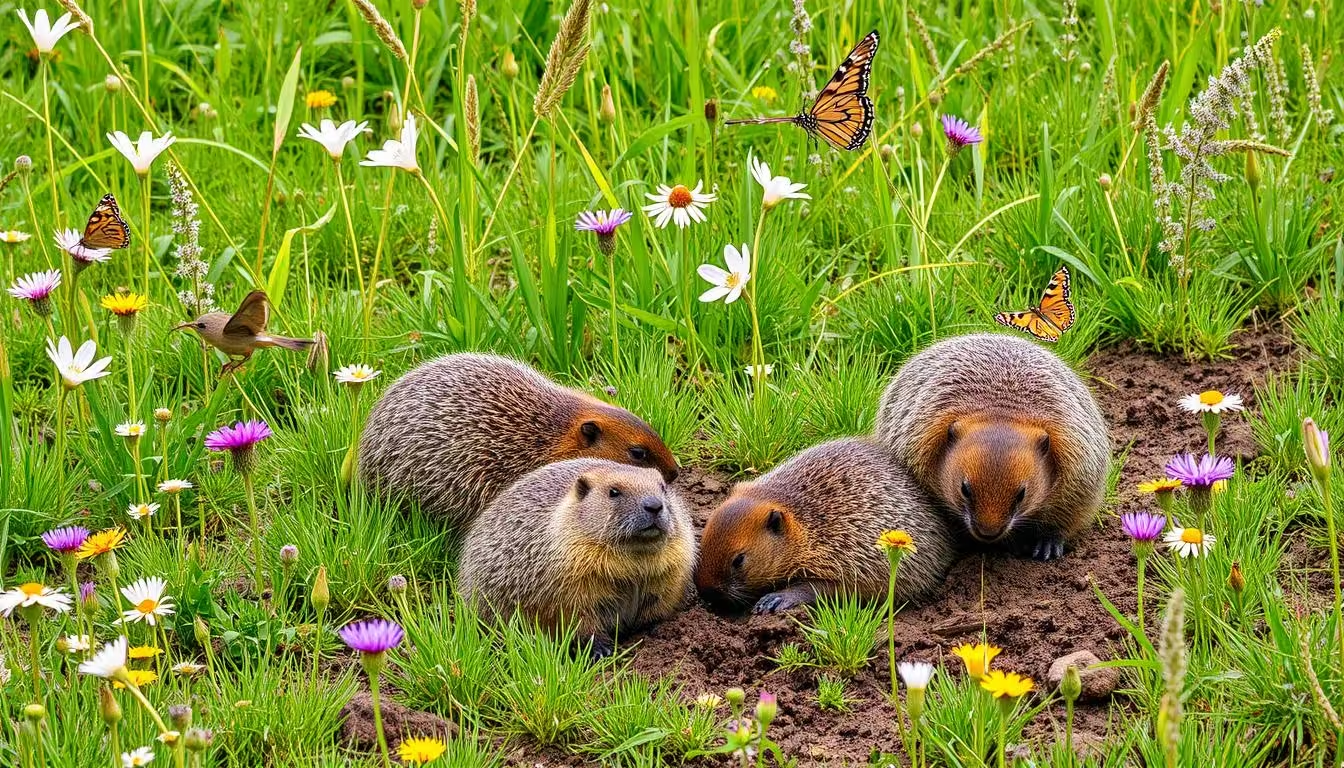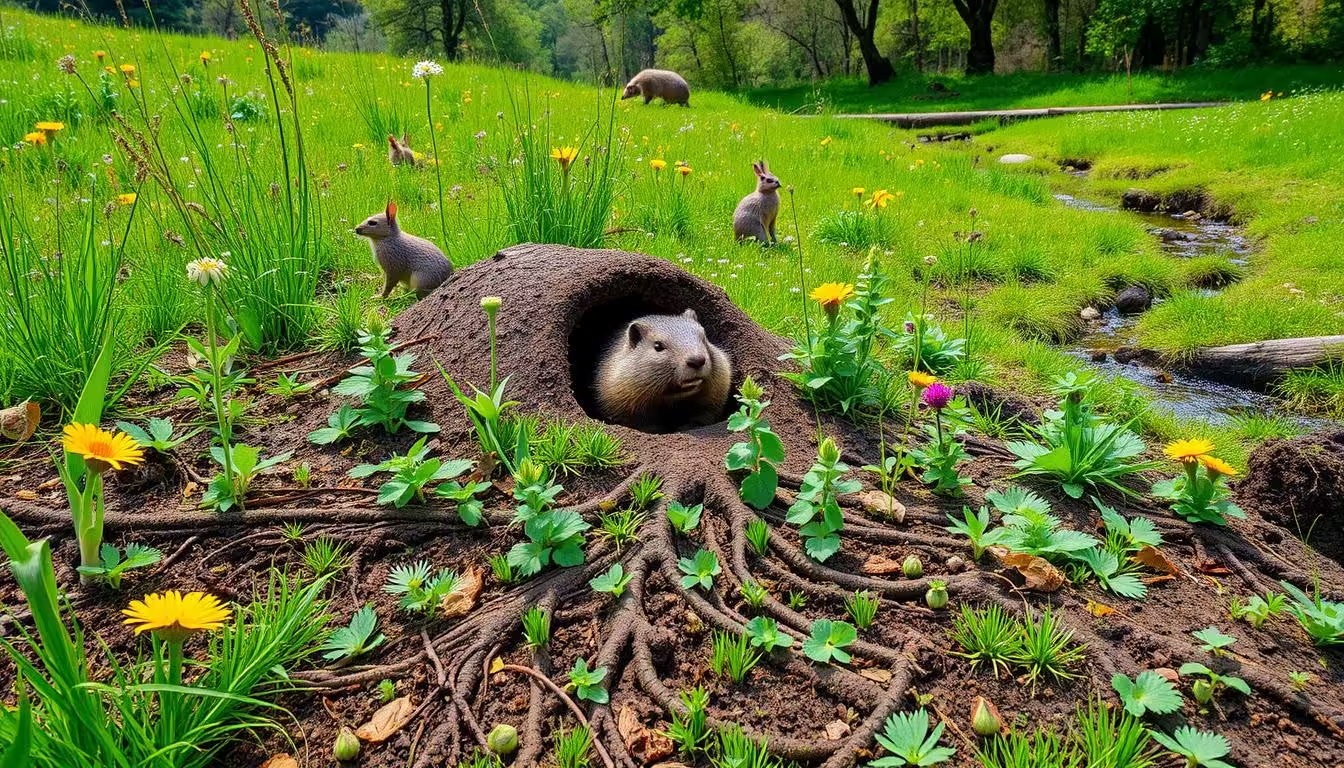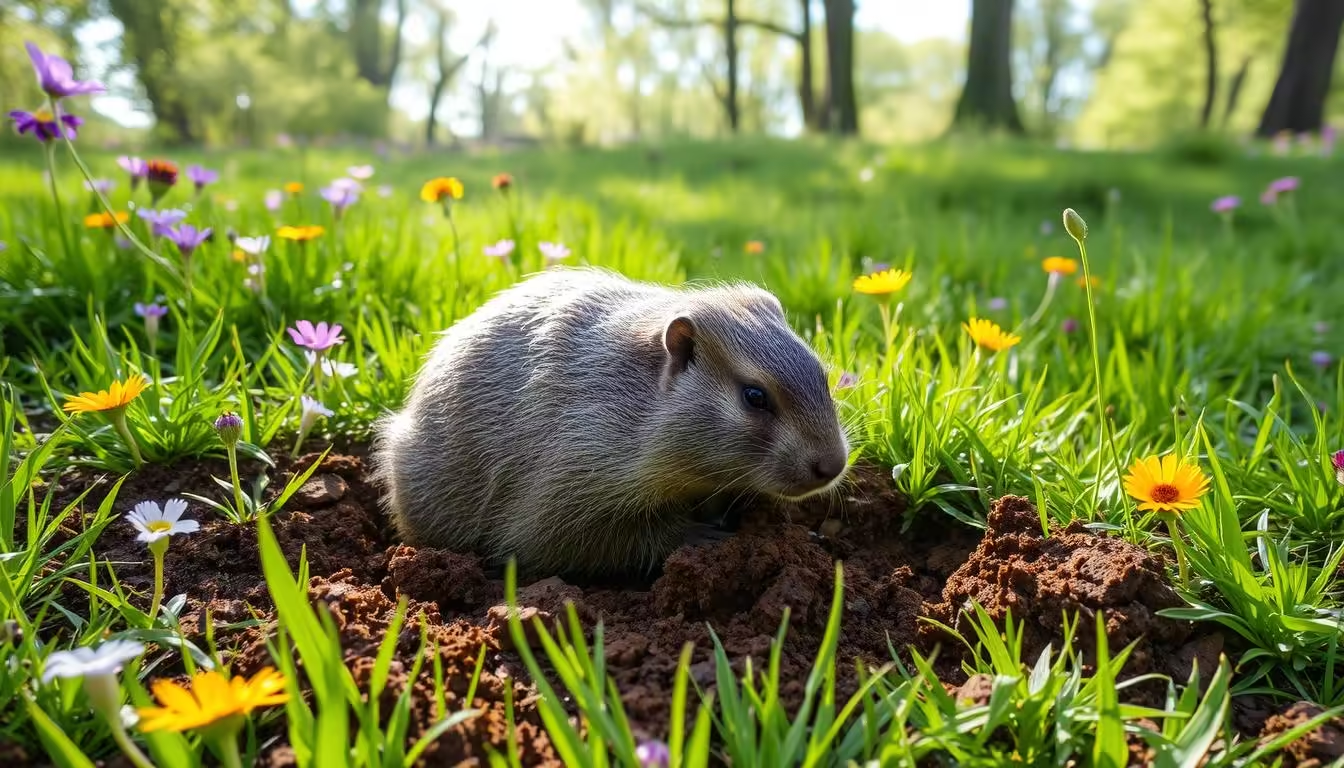Groundhogs, also known as woodchucks or whistle pigs, belong to the squirrel family. They are important ecosystem engineers. They cover a big area in North America, from South Alabama to Canada and North Alaska. They like living in places like pastures, woodlots, open woods, and near streams.
Groundhogs can weigh up to 13 lbs (6kgs). They dig deep tunnels, up to 18 meters long. These burrows are homes for many animals. During winter, they hibernate to stay warm.
Key Takeaways
- Groundhogs are ecosystem engineers, playing a crucial role in the natural landscape.
- Their burrows provide shelter and support biodiversity by offering refuge for other wildlife species.
- Groundhogs’ hibernation helps them survive the harsh winter months.
- These rodents are skilled foragers, feeding on a variety of vegetation, flowers, and field crops.
- Groundhogs contribute to soil health through their burrowing activities, mixing and aerating the soil.
Introduction to Groundhogs and Their Ecosystem Impact
Groundhogs, also known as woodchucks, are fascinating rodents that play a vital role in the ecosystems they inhabit. They are the largest members of the marmot family. These stout creatures measure between 16 to 26 inches long and weigh 4 to 9 pounds. Their burrows can stretch up to 60 feet in length, providing them with a complex network of sleeping chambers, nesting areas, and a cozy hibernation den.
Overview of Groundhog Species
Groundhogs are found primarily in the eastern United States and parts of Canada. They range from the Atlantic Ocean to as far west as North Dakota and down to northern Alabama. While less common in the western regions, these adaptable animals have successfully made themselves at home in urban and suburban areas, thriving where there is ample vegetation to sustain their herbivorous diet.
Brief History and Habitat Preferences
Groundhogs are known for their complex social networks and ability to communicate through a distinctive whistle. These diurnal creatures are excellent swimmers and can even climb trees to escape threats. Interestingly, groundhogs undergo a remarkable hibernation process during the winter months, where their heart rate can drop to just 5 beats per minute, and their body temperature plummets to a chilly 37 degrees Fahrenheit.
With their distinct physical features, such as coarse, bristly fur to shed dirt and valves in their nostrils and ears to prevent dust entry, groundhogs are well-equipped to thrive in their burrow-dwelling lifestyle. As ecosystem engineers, these rodents play a crucial role in shaping the environments they inhabit, making them an integral part of the groundhog ecosystem role and groundhog environmental impact.
“Groundhogs are the largest members of the Marmota genus, which also includes other species of marmots. They are stout, stocky animals with a large head, short legs, and a bushy tail.”
Groundhogs as Ecosystem Engineers
Groundhogs, also known as woodchucks, are skilled engineers. They create intricate burrow systems. These burrows serve as refuge from predators and harsh weather.
The tunnels can extend up to 18 meters long. They have separate chambers for nesting and defecation. By digging and maintaining these burrows, groundhogs improve soil quality through soil aeration and nutrient cycling.
Building Burrows and Their Benefits
Groundhogs are adept at constructing their underground homes. These homes can be quite impressive. They weigh up to 6 kilograms and can dig tunnels as deep as 6 feet.
Their burrow systems offer shelter and a place to raise young and store food. When groundhogs abandon their burrows, other animals like opossums, raccoons, foxes, and skunks occupy them. This increases local biodiversity.
Soil Aeration and Nutrient Cycling
The digging activities of groundhogs are crucial for soil aeration and nutrient cycling. As they burrow, they mix and turn the soil. This introduces air pockets and promotes the breakdown of organic matter.
This process enhances soil structure and fertility. Groundhogs are true ecosystem engineers, shaping the environment to support a wide range of plant and animal life.
“Groundhogs are one of the most important species in maintaining a healthy ecosystem. Their burrows and digging activities have a profound impact on soil quality and biodiversity.”
Groundhogs are a vital component of the natural world. Their role as ecosystem engineers should not be overlooked. By understanding and appreciating their benefits, we can better protect and preserve these remarkable rodents and the environments they call home.
The Role of Groundhogs in Local Food Chains
Groundhogs, also known as woodchucks, are key players in local food chains. They eat plants and are food for others, helping keep ecosystems healthy and diverse.
Prey for Predators
Many animals, like coyotes, foxes, hawks, and owls, rely on groundhogs for food. They help keep the food chain balanced. Without groundhogs, the ecosystem could suffer, affecting many other species.
Contribution to Biodiversity
Groundhogs show the importance of groundhog biodiversity and ecosystem importance of rodents. They eat plants, keeping vegetation in check. Their burrows also help other animals, boosting biodiversity.
Being both consumers and prey, groundhogs are crucial in the food web. Their presence or absence can tell us about the health of their habitat. This makes them important indicators of ecosystem health.
| Predator | Prey |
|---|---|
| Coyotes | Groundhogs |
| Foxes | Groundhogs |
| Hawks | Groundhogs |
| Owls | Groundhogs |
“The presence of groundhogs is a testament to the biodiversity and the ecosystem importance of rodents within their habitats.”
Groundhogs and Plant Life
Groundhogs, also known as woodchucks, are key in managing vegetation. Their eating habits help control plant growth in their homes. They might seem like pests to farmers, but they help spread seeds. This aids in plant reproduction and boosts diversity in some places.
Herbivory: Management of Vegetation
Groundhogs eat many plants like grasses, clover, fruits, and insects. Their eating helps keep vegetation in check. By choosing which plants to eat, they keep the ecosystem balanced. This leads to a more diverse and healthy plant community.
Seed Dispersal and Plant Growth
When groundhogs roam, they carry seeds from the plants they eat. This helps spread seeds and grow new plants. It brings new life to areas and boosts biodiversity.
| Groundhog Statistics | Value |
|---|---|
| Length | 17.75 to 24 inches |
| Weight | around 13 pounds |
| Lifespan | 3 to 6 years in the wild |
| Burrow Depth | 6 feet deep |
| Burrow Width | up to 20 feet wide |
| Burrow Entrances | 2 to a dozen |
Understanding groundhogs’ role in managing vegetation and seed dispersal shows their groundhog ecosystem role and groundhog environmental impact. They play a big part in the health and diversity of plants in their homes.
Groundhogs and Soil Health
Groundhogs, also known as woodchucks, are important for soil health. They improve soil structure and help with nutrient cycling through their burrowing. This is crucial for the ecosystem.
Improving Soil Structure
Groundhogs are great at digging. They create tunnels and chambers underground. This mixing and aeration of soil help it absorb rainwater and nutrients better.
It makes the soil more fertile. This supports plant growth around them.
Role in Decomposition Processes
Groundhogs’ burrows also aid in decomposition. They create a space for microorganisms like bacteria and fungi. These break down dead plants and animals.
This process recycles nutrients back into the soil. It helps the ecosystem stay healthy and productive.
Groundhogs have a positive impact on soil aeration animals and the groundhog environmental impact. Their digging improves soil and helps with decomposition. This makes the natural environment more sustainable and resilient.
“The intricate burrow systems created by groundhogs are truly remarkable, serving as an integral part of the ecosystem’s nutrient cycling and soil health maintenance.”
Impact of Groundhogs on Agriculture
Groundhogs, also known as woodchucks, can affect agriculture a lot. They can damage crops, which leads to problems for farmers. But, they also help farming in some ways.
Crop Damage and Management Strategies
Groundhogs mainly eat vegetables, grasses, and legumes like soybeans and peas. Their big appetite can destroy whole patches of crops. This causes big losses for farmers. They can also damage gardens and vegetable plots.
To deal with groundhogs, farmers use non-lethal methods. Building fences that are 3 feet high and 1 foot underground can keep them out. Some people use ammonia and Epsom salts to repel them, but it’s not always effective. It’s best to talk to local wildlife experts for the right ways to control them.
Benefits of Groundhogs in Farming Practices
Groundhogs might be a problem for farmers, but they also help. Their burrows make the soil better by aerating it and helping nutrients move around. This is good for the soil and can make farming more productive.
| Groundhog Ecosystem Role | Groundhog Environmental Impact |
|---|---|
| Improve soil quality through burrowing and aeration | Cause crop damage and destruction of vegetable patches |
| Facilitate nutrient cycling in agricultural areas | Pose threats to agricultural and residential foundations through extensive burrow systems |
| Provide habitat for other wildlife species | Can be controlled through non-lethal methods like fencing and repellents |
Understanding how groundhogs affect farming can help farmers. They can lessen the bad effects and use the good things groundhogs do for the ecosystem.
Groundhogs and Their Co-Habitants
Groundhogs, also known as woodchucks, are key to keeping ecosystems balanced. They live among other wildlife, adding to the area’s biodiversity.
Interactions with Other Wildlife
Groundhog burrows are homes for many animals. Opossums, raccoons, foxes, and skunks often move in. This creates a network of species that depend on each other.
The tunnels groundhogs dig help smaller animals escape predators. The soil around their burrows also attracts insects and small mammals. This draws in bigger predators, boosting the ecosystem’s diversity.
The Importance of Biodiversity
Groundhogs show a healthy, diverse environment. As ecosystem engineers, they help keep ecosystems balanced. Their digging improves soil, adds nutrients, and creates homes for many species.
Groundhogs support a wide range of life, from tiny insects to big predators. This diversity is vital for the ecosystem’s health. Each part plays a role in keeping the ecosystem in balance.
It’s important to protect groundhogs for healthy ecosystems. Knowing their role in biodiversity helps us preserve these remarkable animals and the diverse communities they support.
How Groundhogs Affect Human Communities
Groundhogs have a big impact on culture, especially on Groundhog Day, February 2nd. This tradition comes from Pennsylvania-Dutch superstition. It has grown into a famous event, even inspiring a movie.
Groundhogs also help with wildlife watching and ecotourism. They live in suburbs, creating special moments for people to connect with nature. This makes local communities appreciate nature more.
Observational Opportunities and Ecotourism
As people learn more about groundhog ecosystem role and groundhog environmental impact, they attract ecotourists. People come to see groundhogs wake up from hibernation and go about their day. This interaction raises awareness and appreciation for these animals.
Groundhogs in Folklore and Culture
Groundhogs are a big part of folklore and culture in the U.S. The most famous example is Groundhog Day. People gather to see if a groundhog’s shadow means spring is coming.
This tradition has grown into a community event. It celebrates the changing of seasons and the groundhog ecosystem role.
| Groundhog Fact | Statistic |
|---|---|
| Groundhogs emerge from hibernation | Late February through mid-March |
| Length of groundhog burrows | Up to 40 feet with interconnected tunnels and rooms |
| Animals that use abandoned groundhog burrows | Rabbits, opossums, raccoons, skunks, chipmunks, weasels, snakes, foxes, and coyotes |
| Woodchuck weight range | Up to 14 pounds |
| Woodchuck length range (including tail) | 16-27 inches |
“Woodchucks have helped in the discovery of archaeological sites such as the Ufferman Site in Ohio and the Meadowcroft Rockshelter site in Pennsylvania, which is the oldest evidence of humans in the Americas.”
Importance of Groundhogs in Scientific Research
Groundhogs, also known as woodchucks, have greatly helped science. They are key in many research areas. This includes studying animal behavior and checking on ecosystem health.
Studies on Animal Behavior
Groundhogs have been studied a lot. This has given us a lot of information about them. For example, a study in Colorado has been going on for 55 years.
This study has shown how groundhogs adjust to changes in their environment. It has also shown how they change their behavior over time.
Ecosystem Health Indicators
Groundhogs are important for checking on ecosystem health. Their digging, eating habits, and numbers give scientists useful data. They are also good at living in coastal areas, showing their strength and importance in their ecosystems.
Efforts are being made to keep their habitats safe. This helps them stay healthy and keep their ecosystems balanced.
| Groundhogs in Scientific Research | Key Findings |
|---|---|
| Hepatitis B Research | Groundhogs (woodchucks) naturally contract the hepatitis B virus, which has aided in the development of medicines and vaccines for human use. The disease processes in woodchucks occur much faster than in humans, allowing for accelerated research. |
| Uncovering Archaeological Sites | Groundhog burrowing activities have inadvertently uncovered major archaeological sites in Ohio and Pennsylvania, providing valuable insights into past human settlements and cultures. |
| Indicators of Ecosystem Health | Groundhog behavior and population dynamics serve as indicators of ecosystem health, offering valuable data for ecological studies and conservation efforts. |
Studying groundhogs keeps giving us new insights. They help us understand animal behavior, diseases, and ecosystem health. As indicators of environmental change and key players in the food chain, they are crucial for science.
Conservation Status and Threats to Groundhogs
Groundhogs are not endangered now, but they face many threats. One big worry is losing their homes to urban growth and farming. As land gets used more, groundhogs have less space, leading to fewer of them in some places.
Climate change is another big problem. Changes in weather and temperature can mess up their hibernation. This makes it hard for them to get ready for winter, hurting their health and ability to have babies.
Habitat Loss and Urbanization
Human activities like building and farming take away groundhog homes. When land gets used for development, groundhogs must find new places to live. This can cause trouble with people, who might see them as pests.
Climate Change Impacts
Climate change is also a big threat. Changes in weather and temperature mess up their hibernation. Groundhogs need to hibernate to survive winter. If this doesn’t work right, it can harm their health and ability to have babies.
To keep groundhogs healthy, we need to work together. Teaching people about how important groundhogs are and protecting their homes is key. This helps ensure these amazing animals stay with us for a long time.
Conclusion: Emphasizing the Importance of Groundhogs
Groundhogs are key players in their ecosystems. They help with soil health, plant spread, and keep biodiversity high. Despite sometimes causing trouble for humans, their role is too big to ignore.
Recap of their Ecosystem Services
Groundhogs are ecosystem engineers. They dig burrows that many animals use for shelter. Their digging also makes the soil better and helps nutrients move around.
As herbivores, they keep plants from growing too much. And as prey, they help feed other animals. This supports a diverse range of species.
Call for Awareness and Conservation Efforts
We need to spread the word about groundhogs’ importance. By understanding and valuing them, we can protect nature’s balance. We can do this through good land use, saving habitats, and teaching others.
This way, we can keep groundhogs and the ecosystems they support safe for the future.



